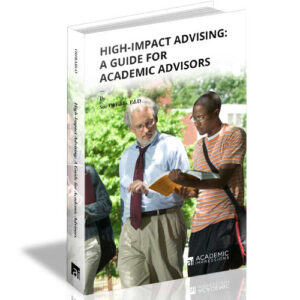
This article is an excerpt from Sue Ohrablo’s acclaimed book High-Impact Advising: A Guide for Academic Advisors, which you can find here.
This week marks the end of yet another hectic week filled with long days, endless phone calls, appointments, emails, and walk-ins. There are times when I get frustrated that I have to answer yet another question about when commencement invitations will be sent out or what the course number is for a particular class. This is not advising. At least, this is not the advising that keeps me motivated and makes me feel like I’m positively contributing to a student’s academic journey.
However, as I look back on the past weeks, I also have to remember the student who was sobbing softly on the phone as she articulated her frustration with a professor whom she felt was harassing her, or the student who proudly shared with me the details of her new job, or the student who referred to me as “The Oracle” just because I am always there to provide answers and direction. As I held these discussions, emails kept coming and the phone kept ringing. I knew I didn’t have the time to focus so intently on each of these students; not if I wanted to help all of the others. Yet I knew that I must devote that time, for it is those types of exchanges that help to develop meaningful advising relationships with students. By taking the time to listen and let each student know that I am genuinely invested in his/her success, I am practicing advising as I know it should be. These interactions far outweigh the lack of satisfaction I experience with the mundane administrative tasks associated with the job.
During this time of year, when we are frantically trying to confer degrees, verify student eligibility to participate in commencement, and help students register for the upcoming term, it is important not to succumb to the temptation to rush through our work with students, whether in person, on the phone, or returning emails. It is at this very time, as we are experiencing a high level of stress, so are our students. Perhaps they need us more than ever.
Here are 3 ways to effectively assist students during high-traffic periods:
1. Triage your calls and emails.
Some advisors feel that it is important to provide “first come, first served” service to students, often including messages such as “I will return your call/email in the order in which it was received.” By doing this during peak periods, advisors risk delaying response to a time-sensitive issue as they respond to inquiries that could be addressed later. I’m not suggesting putting students off, however. Students should feel that you care about them and want to help them, and there are ways to communicate that message using the triage method.
Tips for Triaging with Care:
- “It would be helpful if we met to discuss your questions and engage in academic planning. How does your schedule look the week of …? Since the semester will be under way, we’ll have plenty of time to discuss your plans and address any questions you may have. In the meantime, here are a few resources for your use.”
- “Hi. This is a busy time of the year, and I hate for you to wait. Let’s make an appointment so you don’t have to play phone tag with me (or wait in the lobby, etc.).”
By triaging your student inquiries, you can also identify relatively simple issues that can be addressed quickly. However, I caution advisors not to get caught in the trap of answering a singular question without comprehensively reviewing the student’s record.
2. Do your research.
At this time of year, many of my students are required to take a course that allows them access to dissertation services. Typically, more than half of my inquiries each day are asking what the course number is. It would be so easy to quickly provide it to them, and then move on to the next student. Instead, I make sure to review the student’s file to find out if the student does, indeed, need the course, if he’s confused the course with another, if he’s overlooked a critical issue, and identify other issues he may need to know. This process takes more time, but ultimately, this is the true role of an advisor. By simply answering the question about the course number, and advisor could miss critical information that could academically and financially harm the student. This strategy will also help reduce the number of future inquiries the student may have.
Questions to Consider:
- What does the student need to know right now?
- What other issues are related to this question?
- Is there anything I must do in order to help the student avoid future problems?
3. Be proactive.
Proactive communications via email, social media, and other outlets can help reduce the amount of incoming traffic regarding frequently asked questions. Provide students information in a “just-in-time” manner, sending small, useful communications targeted to specific issues. Use a clear subject line, and target specific audiences, if possible.
Sample Subject Lines:
- Important Graduation Information
- It’s Time to Declare Your Major
- Don’t Miss Out! Important Deadlines
Advising is a complex, sometimes exhausting and frustrating job. However, it can also be an extremely meaningful, rewarding experience as we join students on their academic journey and help them navigate processes and overcome barriers along the way. I encourage advisors to keep this in mind and take a deep breath and refocus if you lose sight of this during the busy season.
Get Sue Ohrablo’s Book High-Impact Advising
 How can academic advisors provide high-quality developmental advising in the face of diminishing resources and increased commitments? We brought this question to Sue Ohrablo, a nationally recognized speaker with 25+ years of experience working with diverse institutions and student populations. In this 300-page, comprehensive training guide, Sue offers practical guidelines for academic advisors.
How can academic advisors provide high-quality developmental advising in the face of diminishing resources and increased commitments? We brought this question to Sue Ohrablo, a nationally recognized speaker with 25+ years of experience working with diverse institutions and student populations. In this 300-page, comprehensive training guide, Sue offers practical guidelines for academic advisors.
“I highly recommend that all academic advising professionals read High-Impact Advising: A Guide for Academic Advisors, as it will help them to enhance key skills needed to establish positive relationships with students, appropriately assess students’ needs, effectively teach students, and efficiently provide high quality service.”
Jacqueline T. Hollins, Assistant Vice Provost/Director of Academic Advisement, SUNY at Buffalo (UB)
“As a department leader in academic advisement, I would use Sue’s book as a training resource and teaching mechanism for advisors. It allows advising professionals to understand today’s complex environment of advising students, beyond just selecting courses.”
Jake Shilts, Director, Advisement & Career Services, Miami Dade College
“Advisors will reap the benefits of this well-balanced, informative guide.”
Shari Saperstein, Associate Dean, College of Undergraduate Studies, Nova Southeastern University
“A student-centered, informative, and practical approach. Dr. Ohrablo presents powerful guidelines geared towards student success for 21st century academic advisors. The handbook offers indispensable information and engaging scenarios that mirror real life college instances that students experience. A key resource tool for academic advisors and higher education professionals.”
Dr. DeLaine Priest, Associate Vice President of Student Development and Enrollment Services, University of Central Florida

